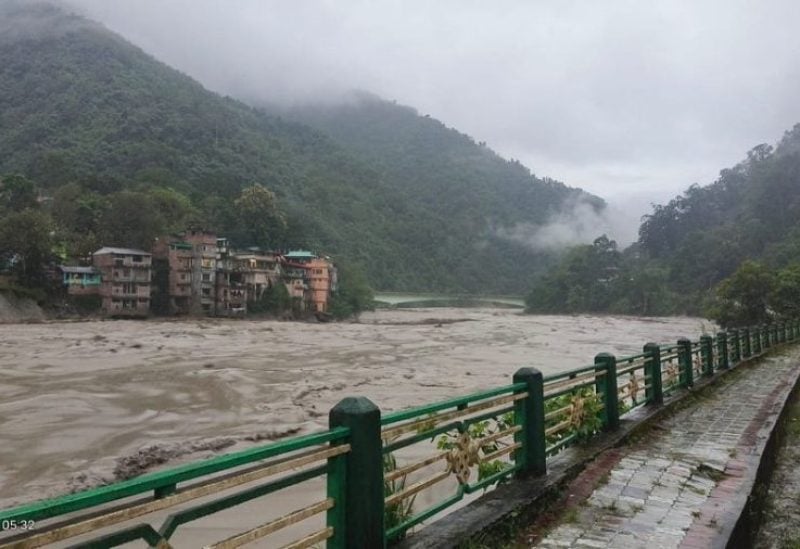Unprecedented Himalayan Lake Flooding: A Deep Dive into the Tragedy
Introduction
In a tragic turn of events, the serene landscape of Sikkim, nestled in the Himalayas, witnessed an unprecedented disaster. The Lhonak Lake, situated in this northeastern Indian state, burst its banks, claiming the lives of 14 individuals, while 102 are still missing. This calamity, triggered by heavy rains, marks the most severe incident of its kind in over five decades.
The Catastrophic Event
The calamity unfolded on a fateful Wednesday, with a sudden cloudburst causing a deluge in the Lhonak Lake, approximately 150 km north of Gangtok, near the Chinese border. The subsequent flash floods wreaked havoc down the Teesta valley, impacting the lives of 22,000 people. Satellite imagery reveals that nearly two-thirds of the lake seems to have been drained, painting a grim picture of the scale of the disaster.
Weather Anomalies and Climate Change
The meteorological department reported that Sikkim experienced an unprecedented 101 mm (4 inches) of rain in the first five days of October, more than double the normal levels. This surge in rainfall, attributed to climate change, surpasses the infamous floods of October 1968, which claimed an estimated 1,000 lives. Alarming predictions indicate heavy rain over the next three days in Sikkim and neighboring states, intensifying the ongoing crisis.
Damaged Infrastructure and Unanswered Questions
Local authorities pointed to the exacerbation of the flooding due to the untimely release of water from the Teesta V dam, operated by the National Hydroelectric Power Corporation (NHPC). Astonishingly, four dam gates were washed away, raising questions about why they were not opened in time. As of early Thursday, the state disaster management agency reported 26 injuries, 102 missing individuals, including 22 army personnel, and the loss of eleven bridges, complicating rescue efforts amid relentless rainfall.
Ripple Effects on Neighboring Regions
The impact of this tragedy extends beyond Indian borders, with Bangladesh on high alert. The Teesta river, downstream of Sikkim, could inundate five districts in northern Bangladesh, warns a water development board official. The ripple effects underscore the interconnectedness of environmental disasters in the region.

In this image released on October 4, 2023, an affected area due to the flood is visible in Sikkim. / Photo by- Sawt Beirut International.
Ground Realities: Scarce Fuel, Available Food
Video footage from the ANI news agency captures floodwaters inundating populated areas, causing the collapse of houses, damage to army bases, and submerging vehicles. Sikkim, a state with approximately 650,000 residents, finds itself cut off from Siliguri in West Bengal due to a collapsed main highway. In the midst of this crisis, fuel scarcity has hit the state capital, Gangtok, while food remains accessible.
A Glimpse into the Past and a Warning for the Future
A 2020 report by India’s National Disaster Management Agency emphasized the growing risk posed by expanding glacial lakes. The melting of Himalayan glaciers, fueled by climate change, heightens the threat to downstream infrastructure and lives. Tragically, this incident is not isolated but part of a concerning trend of flash floods in the Hindu Kush-Himalayan region, underscoring the vulnerability of this area to climate change.
International Response and Reflection
Pema Gyamtsho, director-general of the Nepal-based International Centre for Integrated Mountain Development, lamented, “Sadly, this is the latest in a series of deadly flash floods that ricocheted across the Hindu Kush-Himalayan region this monsoon, bringing the reality of this region’s extreme vulnerability to climate change all too vividly alive.” The international community must reflect on the urgency of addressing climate change to prevent further catastrophes.
Ongoing Challenges and Future Preparedness
Rescue operations face substantial challenges, with washed-away bridges and continuous rainfall hampering efforts. The downstream impact on Bangladesh necessitates coordinated efforts for effective disaster management. As we grapple with the immediate aftermath, it becomes imperative to focus on long-term strategies for mitigating climate change and enhancing preparedness for similar future events.
Conclusion
The Himalayan lake flooding in Sikkim is a stark reminder of the environmental challenges our world faces. Beyond the immediate tragedy, it underscores the critical need for global initiatives to combat climate change. As communities rally to support one another in the face of adversity, it is our collective responsibility to work towards a sustainable future that safeguards the vulnerable regions of our planet.